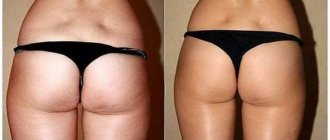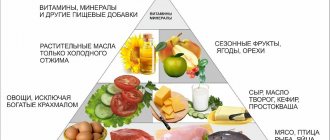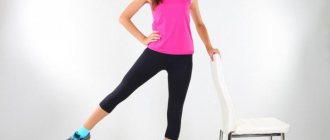In the realities of modern times, the female half of the population has a great desire to lose weight, especially while waiting for the onset of the summer period, and if earlier girls began to ask this question at least from the age of eighteen, today the goal of losing weight has begun to “catch” even teenagers.
Teenagers are more independent and spend a lot of time with their peers, which means they consume more food and drinks based on social preferences. But the key dietary recommendations for teens are much the same as for adults: eat a varied diet and limit added sugar, saturated fat and salt. The basis of the diet should be: vegetables and fruits, whole grains (bread, cereal, pasta), lean meat and poultry, fish and seafood, legumes, unsalted nuts and seeds, vegetable oils.
An unhealthy desire to lose extra pounds in adolescence can be dangerous for their not yet fully formed body and hormonal system. Yes, it is almost impossible to convince a child 11-16 years old that his body is still growing and changing, and diets can harm this process. Therefore, you should not interfere or prohibit, but simply help your child organize proper nutrition.
Modern children actively use the Internet, therefore, parents must find the correct information earlier and be able to present it to a child who has already formed an obsession with losing weight, so that this dangerous desire disappears.
What a teenager from 11 to 17 years old needs to know about diet
Content:
- What a teenager from 11 to 17 years old needs to know about diet
- What foods are recommended to be removed from a teenager's diet?
- Rules for teenage diet for weight loss
- Diet options for teenagers
- General recommendations
All metabolic processes in a growing body occur somewhat differently compared to an adult body, therefore, if there are no medical indications for losing weight (overweight and obesity, diabetes, heart failure, etc.), you should not starve yourself with diets.
It is very important for teenagers, starting from 11 years old and up to 17 years old, to provide their body with all the necessary microelements and vitamins. If you remove all the necessary components for the full development of the body, then in five to ten years you will experience problems with both weight and health. Most often, the problem with extra pounds in adolescence disappears by the time the body fully matures.
Teenage diets at 11, 12, 13 years old and up to 17 years old can cause problems: with hormonal levels, skin condition, hair and nails. It is important to understand that a teenage diet is not starvation, it is a properly selected healthy diet without fast food, sweets and other junk food.
To get more results from a healthy diet, it is important to combine it with adequate physical activity - running, swimming, frequent walks, rollerblading and cycling. The main thing for a teenage diet is to regularly eat healthy and nutritious foods.
Losing 10 kg weight in a teenager without harm to health: physical activity
Of course, dietary restriction is not the only way to lose weight. To lose weight, you just need to move as much as possible. Enroll your child in an interesting sports section: dancing, wrestling, tennis, fencing, in the end! There are a lot of options. The main thing is to choose a sport for a boy or girl that he will really like, and then losing weight will not take long. The child will strive for better results, he will be interested in spending time, and, without noticing it, he will begin to lose weight.
Walk your child to school if possible. Walking is one of the best ways to lose weight.
If you can’t sign up for a sports section, let the child study at home: there are a lot of exercises and complex activities that the child will like and bring good results.
If a child needs to lose 10 kg per month, which is rapid weight loss, physical activity is required. Otherwise, stretched skin will hang very unsightly in place of the melted fatty tissues. Losing weight is a rather complex process, influenced by several factors, including the individual characteristics of the child. Even if you can’t immediately lose 10 kg in a month, teach your child not to be upset. Surely he will lose weight, if not in a month, then in one and a half or two months. The main thing is that it is without harm to health and brings joy to the child. When he sees the results, he will be more than rewarded for his efforts.
What foods are recommended to be removed from a teenager's diet?
It is worth understanding that the diet for 11-15 years old will be somewhat different from the diet of a teenager 16 and 17 years old. But the main list of prohibited foods is the same for everyone:
- fast foods of any kind;
- chips;
- flour;
- sweets.
Now, in more detail, why it is so important to protect your child from all these “goodies”. Unhealthy diets and lack of physical activity contribute to excess weight at this stage of life and an increased risk of chronic diseases (diabetes, cardiovascular disease) in older age.
Eating habits that develop during childhood and adolescence are likely to last a lifetime.
The first thing to exclude is French fries, cheeseburgers, hamburgers and other fast food, so beloved by all children. Since these dishes saturate the body with excess calories and “bad” cholesterol. The second exception is chips. They instantly saturate the body, are tasty, but at the same time cause a feeling of habit and contribute to the gain of extra pounds; the product belongs to the “high-calorie” group. Buns – eating baked goods also contributes to weight gain. But this does not mean that you need to completely exclude bread from your diet. It is not recommended to consume bread in large quantities and fresh - it is better to dry the slices. Sweets - candies, jellies, marshmallows, waffles - this list goes on and on.
Yes, it is difficult for a child to give up such small joys, but no one calls for this, you just need to limit the amount of consumption of sweets, or more precisely, added sugar.
Sweet soda - you need to understand that this product not only affects the appearance of excess weight, but also harms the entire body as a whole. You need to gradually accustom yourself to drink only clean, ordinary water, without dyes or other harmful additives. Factory juices - most often a large amount of sugar is used as a preservative.
If you want to add juices to your diet, it is better to make them yourself, mix healthy, nutritious and fresh fruits/vegetables.
Don't eat before bed
Late or even night snacks contribute not only to disruption of the digestion process, but also to unwanted weight gain for a 17-year-old teenager. The fact is that the main principle of metabolism is the rapid digestion of food products with the subsequent absorption of healthy proteins, carbohydrates and fats. However, by having dinner before bed, you greatly disrupt this established process, as a result of which the body will absorb a much larger amount of fat than a young body needs.
We recommend brushing your teeth between 6 and 7 p.m. to avoid the temptation to snack at 10 p.m.
Rule #4: Don't eat anything at least an hour before bedtime!
Rules for teenage diet for weight loss
It is important to remember that only a doctor should select a diet for a teenager 11-15 years old, based on a preliminary professional examination and medical indications. Excessive independence in this matter can provoke serious and irreversible consequences.
| Product | A portion | Calories |
| Burgers, hamburgers | 1 PC | 490 |
| French fries | 1 large | 460 |
| Soda | 330 ml | 139 |
| Pizza | 250 g | 682 |
| Chicken wings fries | 300 g | 726 |
| Chocolate without filling | 45 g | 237 |
| Chocolate cake | 450 g | 1710 |
| Candies | 100 g | 230 |
Let's look at a few general rules that will help you get the desired shape through nutritional correction:
- To lose weight, a girl/boy aged 11-17 years needs to slightly reduce the diet - the calorie content must be “cut” by twenty percent. A teenage girl should consume 2,500 kilocalories per day, and boys - 2,700 kilocalories.
- The diet must necessarily include healthy carbohydrates (porridge, fruits, vegetables) - 50% (carbohydrates), 25% (proteins), 25% (fats). For example: adolescents 11-13 years old need to consume approximately 2.2 g of protein per kg of body weight per day; carbohydrates: from 13 to 18 years, approximately 4-7 g per kg of body weight; and fats up to 2 g per kg of body weight.
- Meals should be regular, preferably four times a day. It is not recommended to skip meals.
- Breakfast is the main and most important meal of the day; carbohydrate and protein foods should predominate in breakfast in order to charge the body with energy.
- Lunch should also include a full range of healthy foods. The more vegetables and fruits of all colors and the greater the variety of them at each meal, the better.
- For afternoon snacks and dinner, it is recommended to eat light and low-calorie foods and dishes.
- It is important to eliminate fatty and fried foods and processed meats (bacon, sausages and hot dogs) from your diet.
- It is better to stew, bake or boil everything.
- Proper nutrition must be combined with physical activity - this is not only ideal physical fitness, it also means weight correction, excellent posture, and health.
If you follow these simple rules, you can get rid of excess weight and maintain your health. The teenage diet is aimed at gradual and harmless weight loss.
The most effective exercises in the gym that help remove fat from thighs
A SET OF EXERCISES FOR BURNING FAT ON BUGS IN THE GYM
| Exercises | Sets | Repetitions/Time |
| Romanian deadlift with dumbbells | 3 | 15 |
| Reverse hyperextension | 3 | 15 |
| Stepping onto the platform | 2-3 | 10-12 |
| Cardio training on a stepper | 1 | 15-30 min |
Read: Barbell exercises for buttocks for girls
Romanian deadlift with dumbbells
A simplified version of the classic Romanian barbell deadlift. Performed on straight legs. Thanks to this, the load is focused on the gluteal muscles and biceps femoris. In this case, the quadriceps muscles work as stabilizers of the knee joints. The calf muscles, lower back and back are additionally loaded.
Romanian deadlift with dumbbells
Technique:
- Stand up straight. Feet shoulder width apart. Feet are parallel. Knees slightly bent.
- Before performing, bend your lower back and straighten your shoulders. Maintain this position throughout the entire working set.
- As you exhale, gently squat, moving your hands with dumbbells along the front of your thighs to the middle of your shins.
- As you inhale, slowly rise to the starting position.
How much: 3 sets, 15 repetitions.
Variant of rows with a barbell, similarly performed with dumbbells
Contraindications: The exercise produces a noticeable axial load, so it is not recommended for people with diseases of the musculoskeletal system and problems with the spine - hernias, protrusions, compression injuries. If you have diseases of the joints of your hands, consult a trainer before performing.
Tip: Do not bend your back, this may cause spinal injury. Beginners with poor hamstring stretch will compensate by overloading the lower back or rounding the back. Therefore, at the initial stage you need to work out the technique, working out with a small weight in front of a mirror or under the supervision of a trainer.
Reverse hyperextension
An effective exercise for working the buttocks and creating a beautiful leg silhouette.
Reverse hyperextension
Technique:
- Lie on the exercise bench with your stomach down so that your feet touch the floor with your toes, and your body is placed on the bench from your shoulders to your hip joints.
- Hold the bench handles with your hands (if they are missing, place your hands under your chest or grab the bench).
- As you exhale, raise your legs in line with your torso.
- Then, while inhaling, gently lower them to the starting position.
Number of repetitions: 3 sets of 15 repetitions.
Contraindications: Injuries of the lumbosacral spine and coccyx. If you experience back pain before or after performing the exercise, consult a specialist.
Tip: To do this at home, you can use two chairs or a pair of stools placed side by side.
Stepping onto the platform
An exercise to work the quadriceps femoris and buttocks (heavy load), the inner surface and hip flexor (medium load). The abs, back and lower back are additionally loaded.
Technique:
- Feet shoulder width apart. Hands along the torso. The back is straight. Raise your working leg to an elevated position, keeping your body straight, with your thigh parallel to the floor. As you exhale, push off with your other leg and stand on the platform, straightening your working leg. Pause at the top and smoothly lower into IP.
How much: 2-3 sets of 10-12 repetitions for both legs.
Stepping onto the platform
Tip: To do this at home, instead of a platform (gymnastic bench), you can use a stool or other elevation 40-60 cm high.
Frequent mistakes are too fast a pace and facilitating execution due to the inertia that occurs when moving the body forward. For this exercise, the emphasis is on the muscles being worked and maintaining balance, rather than the speed of execution and the number of repetitions.
Cardio training on a stepper
Cardio exercise strengthens your leg muscles and effectively burns fat deposits on your thighs. Additionally, the cardiovascular and respiratory systems are trained.
Cardio training on a stepper
Technique:
- Step onto the stepper. Position your feet so that your knees are far enough apart and not touching during exercise. Keep your back straight, slightly leaning your body forward is allowed. Feet are parallel.
- Perform walking movements as if you were climbing steps. Gradually increase the pace until you feel the strain.
- Maintain deep, even breathing throughout your workout. If your breathing becomes difficult, slow down to a comfortable pace.
How long: 15-30 min. (depending on preparation), 2-3 times a week.
Advice! To strengthen your legs, any cardio machine is suitable: a treadmill, stepper, elliptical or exercise bike. But the stepper is more suitable for focused work on the target area.
Source
Diet options for teenagers
Diet for a teenager 11-12 years old
Breakfast – one hundred and fifty grams of low-fat cottage cheese with honey, 1 soft-boiled egg, one glass of milk or tea.
Lunch – light vegetable soup, one hundred and fifty grams of low-fat boiled chicken fillet.
Afternoon snack – a glass of any vegetable juice, toast with a piece of butter and hard cheese.
Dinner – salad of fresh vegetables and olive oil, low-fat fish baked in the oven.
You can select other products, just take into account the calorie content and quantity.
Diet option for teenagers 13 years old and 14 years old
Breakfast – light buckwheat porridge on water with tender boiled veal, a glass of milk or tea.
Lunch – low-fat baked fish, vegetable salad with carrots and cabbage and olive oil, a glass of tea.
Afternoon snack – fruit sponge cake (any fruit except grapes and banana).
Dinner – unsweetened cottage cheese casserole and yogurt.
Diet option for teenagers 15 years old, 16 years old
Breakfast – two toasts, one hundred grams of boiled lean meat, two tomatoes, a glass of tea.
Lunch – lean borscht, one soft-boiled egg, baked potatoes, cabbage salad with olive oil.
Afternoon snack – yogurt or kefir with crackers.
Dinner – boiled chicken fillet, a glass of green tea.
Diet option for a 17 year old teenager
Best materials of the month
- Coronaviruses: SARS-CoV-2 (COVID-19)
- Antibiotics for the prevention and treatment of COVID-19: how effective are they?
- The most common "office" diseases
- Does vodka kill coronavirus?
- How to stay alive on our roads?
Breakfast – one hundred and fifty grams of boiled chicken fillet, a glass of milk or tea.
Lunch – buckwheat-mushroom soup, two soft-boiled eggs, a glass of tomato juice.
Afternoon snack – any fruit, except banana and grapes, biscuit (150 grams).
Dinner – fifty grams of hard cheese, yogurt, one potato, baked in the oven and with the skin on.









